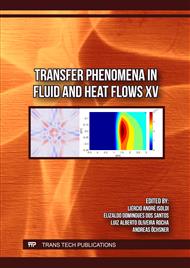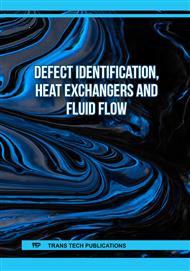[1]
S.F. Ahmed, M.M.K. Khan, A parametric analysis of the cooling performance of vertical earth-air heat exchanger in a subtropical climate, Renewable Energy, 172 (2021) 350-367.
DOI: 10.1016/j.renene.2021.02.086
Google Scholar
[2]
M.J. Bordbari, A.R. Seifi, M. Rastegar, Probabilistic energy consumption analysis in buildings using point estimate method, Energy, 142 (2017) 350-367.
DOI: 10.1016/j.energy.2017.10.091
Google Scholar
[3]
X. Bai, R.J. Dawson, D. Ürge-Vorsatz, G. Delgado, A.S. Barau, S. Dhakal, D. Dodman, L. Leonardsen, V. Masson-Delmotte, D.C. Roberts, S. Schultz, Six research priorities for cities and climate change. Nature Climate Change, 555 (2018) 23-25.
DOI: 10.1038/d41586-018-02409-z
Google Scholar
[4]
C. Li, Y. Zhang, Y. Xie, When an attacker meets a cipher-image in 2018: A year in review, Journal of Information Security and Applications, 48 (2019).
DOI: 10.1016/j.jisa.2019.102361
Google Scholar
[5]
P.G. Machado, R.S. Brum, D. Buske, Evaluation of the thermal potential of earth-air heat exchangers. Ciência e Natura, 43 (2021).
Google Scholar
[6]
R. Lamberts, E. Ghisi, A.L.P. Abreu, J.C. Carlo, J.O. Batista, D.L. Marinoski, A. Naranjo, V.C.P. Duarte, Desempenho Térmico de Edificações, seventh ed., Laboratório de Eficiência Energética em Edificações, Universidade Federal de Santa Catarina, Florianópolis, 2016.
DOI: 10.5196/physicae.v11i11.311
Google Scholar
[7]
M.K. Rodrigues, R.S. Brum, J. Vaz, L.A.O. Rocha, E. dos Santos, L. Isoldi, Numerical investigation about the imporvement of the thermal potential of an earth-air heat exchanger (EAHE) employng the constructal design method, Renewable Energy, 80 (2015) 538-551.
DOI: 10.1016/j.renene.2015.02.041
Google Scholar
[8]
J. Sobti, S. Singh, Earth-air heat exchanger as a green retrofit for chandıgarh - a critical review. Geotherm Energy, 14 (2015) 333-340.
DOI: 10.1186/s40517-015-0034-4
Google Scholar
[9]
C.B. Plamer, Modelagem computacional e método constructal design aplicados a um conversor de energia das ondas do mar do tipo coluna de água oscilante (CAO) analisando a influência em seu desempenho da variação da razão entre o volume de entrada e o volume total da câmara hidropneumática, Dissertação de Mestrado, Programa de Pós-graduação em Modelagem Computacional, Universidade Federal do Rio Grande, Rio Grande, 2016.
DOI: 10.5380/rber.v6i3.52995
Google Scholar
[10]
R. Lamberts, L. Dutra, F.O.R. Pereira, Eficiência Energética na Arquitetura, third ed., Eletrobras/Procel, Rio de Janeiro, 2014.
Google Scholar
[11]
Information on https://www.epe.gov.br/pt/publicacoes-dados-abertos/publicacoes/balanco-energetico-nacional-(2021)
Google Scholar
[12]
Information on https://abividro.org.br/wp-content/uploads/2021/08/Manual-Tecnico-Vidro-Plano-Para-Edificacoes.pdf
Google Scholar
[13]
M. Casini, Active dynamic windows for buildings: A review. Renewable Energy, 119 (2018) 923-934.
DOI: 10.1016/j.renene.2017.12.049
Google Scholar
[14]
I. Lahmar, A. Cannavale, F. Martellotta, N. Zemmouri, The impact of building orientation and window-to-wall ratio on the performance of electrochromic glazing in hot arid climates: A parametric assessment. Buildings, 12 (2022).
DOI: 10.3390/buildings12060724
Google Scholar
[15]
M. Corsi, R. Zmeureanu, P. Fazio, Modeling of electrochromic glazing switching control strategies in micro-DOE-2.1, Centre for Building Studies, Concordia University, 2023.
Google Scholar
[16]
P. Tavares, H. Bernardo, A. Gaspar, A.G. Martins, Control criteria of electrochromic glasses for energy savings in mediterranean buildings refurbishment, Solar Energy, 134 (2016) 236-250.
DOI: 10.1016/j.solener.2016.04.022
Google Scholar
[17]
A. Cannavale, F. Martellotta, P. Cossari, G. Gigli, U. Ayr, Energy savings due to building integration of innovative solid-state electrochromic devices. Energy, 225 (2018) 975-985.
DOI: 10.1016/j.apenergy.2018.05.034
Google Scholar
[18]
H. Qing, M.U. Hossain, S.T. Ng, M. Skitmore, Energy-efficient window retrofit for high-rise residential buildings in different climatic zones of China. Sustainability, 11 (2019).
DOI: 10.3390/su11226473
Google Scholar
[19]
J.A. Pouey, Projeto de edificação residencial unifamiliar para a Zona Bioclimática 2 com avaliação termoenergética por simulação computacional, Dissertação de Mestrado, Programa de Pós-graduação em Arquitetura e Urbanismo, Universidade Federal de Pelotas, Pelotas, 2011.
DOI: 10.21475/ajcs.17.11.03.pne219
Google Scholar
[20]
R. Dalbem, J.M.R. Freitas, E.G. Cunha, Passivhaus concept applied to brazilian climate. Revista de Arquitetura IMED, 4 (2015) 26-36.
DOI: 10.18256/2318-1109/arqimed.v4n1p26-36
Google Scholar
[21]
J.S. Porto, Intelligent window thermoenergetic and optical performance by computational simulation, Tese de Doutorado, Programa de Pós-graduação em Ciências e Engenharia de Materiais, Universidade Federal de Pelotas, Pelotas, 2019.
DOI: 10.21475/ajcs.17.11.03.pne219
Google Scholar



